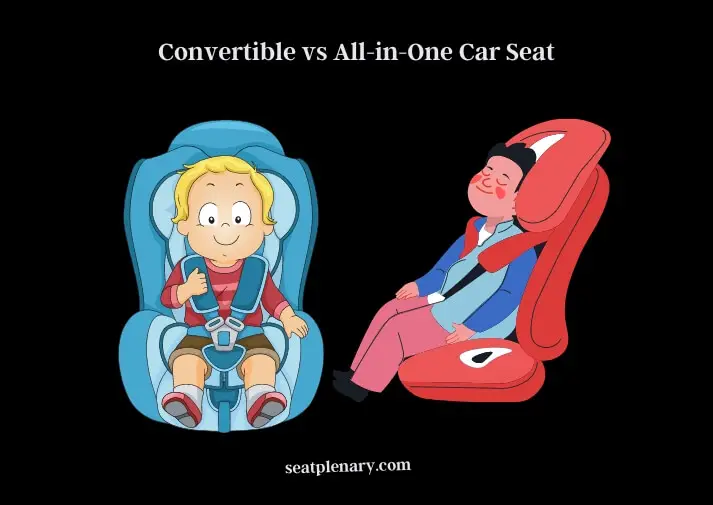As a parent, you’re probably facing the daunting task of choosing the perfect car seat for your little one. You’ve heard of convertible and all-in-one car seats, but you might be wondering what the differences are and which one is the best for you. In this comprehensive article, we’ll explore the advantages and disadvantages of convertible vs all-in-one car seats, so you can make an informed decision for your precious cargo.

Introduction: Convertible vs All-in-One Car Seats
What’s the Difference?
Convertible car seats can transition from a rear-facing seat for infants to a forward-facing seat for toddlers. This means that you can use the same seat for a longer time as your child grows.
All-in-one car seats, on the other hand, offer three modes: rear-facing, forward-facing, and booster seat. These seats are designed to grow with your child from infancy through the booster seat stage, giving you one product to meet all your child’s car seat needs.
Key Features to Look For
When comparing convertible vs all-in-one car seats, there are several factors to consider:
- Safety ratings
- Comfort and support
- Ease of installation
- Adjustability
- Weight and height limits
- Price
- Space requirements
Convertible Car Seats
Pros
- Lower cost compared to all-in-one car seats
- Easier to install and adjust
- Can be used for a longer time than infant car seats
Cons
- May not provide a perfect fit for smaller infants
- Can be bulky and heavy
- Need to purchase a separate booster seat later on
Top Convertible Car Seat Picks
- Graco 4Ever Extend2Fit
- Britax Marathon ClickTight
- Chicco NextFit Zip
All-in-One Car Seats
Pros
- One car seat for all stages of your child’s growth
- Saves money in the long run
- Versatile and adaptable
Cons
- More expensive upfront
- Can be more challenging to install and adjust
- May take up more space in your vehicle
Top All-in-One Car Seat Picks
- Graco 4Ever DLX
- Evenflo Symphony Elite
- Diono Radian 3RXT
Convertible vs All-in-One Car Seat: Which Is Right for You?
To determine the best option for your family, consider your budget, your vehicle’s size, and your child’s growth rate. If you’re looking for a more affordable option and don’t mind purchasing a separate booster seat later on, a convertible car seat might be the better choice. If you prefer a one-time investment and want a seat that covers all stages of your child’s growth, an all-in-one car seat is a wise choice.
Car Seat Safety Tips
- Always follow the manufacturer’s guidelines for weight and height limits.
- Register your car seat for safety recall notifications.
- Make sure the car seat is installed correctly and tightly secured.
- Adjust the harness straps to ensure a snug fit.
- Never place a rear-facing car seat in the front seat with an active airbag.
Installation and Maintenance
- Follow the car seat’s manual for installation instructions.
- Check the tightness of the installation regularly.
- Clean the car seat according to the manufacturer’s recommendations.
- Replace the car seat after an accident, even if it appears undamaged.
FAQs
How long can my child stay in a rear-facing car seat?
Experts recommend keeping your child in a rear-facing car seat until at least age 2 or until they reach the maximum height and weight limits for the seat.
When should I switch to a forward-facing car seat?
You should switch to a forward-facing car seat when your child outgrows the rear-facing mode’s height or weight limits, typically around age 2 or older.
What is the best age to transition to a booster seat?
Children should transition to a booster seat when they outgrow their forward-facing car seat, usually around 4 to 7 years old, depending on the child’s size and the car seat’s limits.
Can I use a secondhand car seat?
It’s not recommended to use a secondhand car seat, as you may not know its history or if it has been involved in an accident. Car seats also have expiration dates, which may be difficult to verify with a used seat.
How do I know if my car seat is installed correctly?
To ensure correct installation, follow the car seat manual and check for tightness. You can also visit a local car seat inspection station for assistance.
How often should I replace my car seat?
Car seats typically expire 6 to 10 years after the manufacture date, which can be found on the seat’s label. Replace your car seat after an accident, even if it appears undamaged.
Conclusion
In the battle of convertible vs all-in-one car seats, the best choice ultimately depends on your individual needs and preferences. By considering factors such as cost, vehicle size, and your child’s growth, you’ll be well-equipped to make an informed decision. Whichever option you choose, remember to prioritize safety and always follow the manufacturer’s guidelines for proper use and installation.
